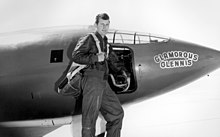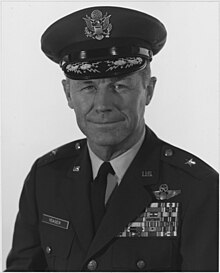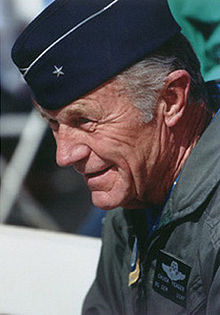Chuck Yeager
Charles Elwood "Chuck" Yeager (born February 13, 1923 in Myra , West Virginia , † December 7, 2020 in Los Angeles , California ) was an American veteran aviator of World War II , test pilot and brigadier general . He was the first person to break the sound barrier in level flight in 1947 . In the following years, Yeager set further speed and height records.
Life
Early years
Yeager was the second of five children from farmers Susie Mae and Albert Hal Yeager. He had two brothers, Roy and Hal Jr., and two sisters, Doris Ann and Pansy Lee. Six -year-old Roy accidentally shot his younger sister Doris Ann while playing with his father's shotgun .
The family name is derived from the German word "Jäger" and is pronounced similarly in English. His ancestors were Germans who Anglicized their names.
Yeager graduated from high school in Hamlin , West Virginia. He had his first encounter with the military while attending the Citizens Military Training Camp at Fort Benjamin Harrison in 1939 and 1940.
Second World War
Yeager signed up as a volunteer with the US Army Air Forces on September 12, 1941 and was trained as an aircraft mechanic at Victorville Army Air Field , California . In July 1942 he began flight training as part of the “Flying Sergeants” program. On his first flight he became airsick , but that didn't deter him. Soon his extraordinary flying talent became apparent. On March 10, 1943, he received his license and promotion to flight officer in Luke Field , Arizona . He became the 357th Fighter Group in Tonopah, Nevada, and began his fighter pilot training on a Bell P-39 .
In December 1943, Yeager's group was relocated to Europe and stationed in Great Britain at the RAF station Leiston . He flew a P-51 Mustang there , which he named "Glamorous Glennis" after his girlfriend and later wife Glennis Faye Dickhouse . After an aerial victory, Yeager was shot down on his eighth mission over France on March 5, 1944. With the help of the French Resistancehe managed to escape to Spain on March 30; he returned to Britain on May 15th. Despite the rule that pilots who were able to flee from an occupied country should no longer fly over enemy territory in order to protect the resistance groups, Yeager was able to be used again as a fighter pilot over Europe after he and the escaped bomber pilot Capt. Fred Glover had a conversation with the Supreme Allied Commander, General Dwight D. Eisenhower , on June 12, 1944 . Since the invasion of Europe had already started and the Maquis-Resistance groups were in open combat with the German Wehrmacht, Yeager and Glover could no longer put their rescuers in danger if they were captured. After Eisenhower had obtained permission from the War Department to decide for himself in this case, he complied with the request of the two pilots. A short time later, Yeager became the first flying ace of his squadron with five more kills . He was able to achieve these five kills in a single day and was awarded the Silver Star for this.
Yeager ended the war with 11.5 official kills, with an aerial victory over a jet aircraft, an Me 262 , on November 6, 1944 . In addition to the 11.5 kills, there was another one during a training flight at the time when he was not allowed to fight again after his escape. He shot down a Ju 88 that attacked a damaged B-17 Flying Fortress , thus saving the life of the B-17 crew. Since he had attacked contrary to orders, the film from his shooting camera , which documented the shooting, became his wingman Eddie Simpsonhanded over and thus awarded the aerial victory. Yeager flew his 61st and final mission in World War II on January 15, 1945 and returned to the United States in February 1945 with the rank of captain . On February 26, 1945, he married Glennis Dickhouse, whom he had already met during his training.
In his autobiography, Yeager describes that he received an order to fire “everything that moved” (“strafe anything that moved”) in a specified area on German soil. The aim of these low-flying attacks was to demoralize the population. Yeager wrote that at the briefing, he told his neighbor that it would be better to be on the winning side if he participated in these stakes.
The flight through the "sound barrier"
Yeager stayed in the Air Force after the war and became a test pilot. He was selected along with other pilots such as Bob Hoover to fly the Bell X-1 rocket-propelled aircraft as part of a research program . Yeager nicknamed the experimental aircraft "Glamorous Glennis" after his wife Glennis. On October 14, 1947, Yeager succeeded in breaking the sound barrier with this aircraft at an altitude of 13,100 m (43,000 ft) . Under temperature and air pressure conditions , where the speed of sound is 1060 km / h, it reached a speed of 1125 km / hor Mach 1.06. In contrast to previous, unoccupied flights at supersonic speed, however, no dive was necessary for this.
Two days before this flight he had broken two ribs while riding a night out with his wife; on the ride home he had realized too late that a gate was closed. For fear of not being allowed on the flight, he did not go to the hospital at his base, but to a veterinarian in the area and only told his good friend Jack Ridley about the broken ribs. This injury made it impossible for Yeager to close the hatch on the X-1, so Ridley got him the end of a broomstick that Yeager could use as a lever to close the hatch. For the first official supersonic flight he was awarded the MacKay Trophy, the Collier Trophy and 1954 the Harmon International Trophy in 1948 . The Bell X-1 is now in the permanent exhibition of theNational Air and Space Museum of the Smithsonian Institution .
Further work with the US Air Force
Yeager later broke numerous other speed and altitude records. He was also the first American pilot to fly a MiG-15 , with which a North Korean pilot had previously set off for South Korea. In the second half of 1953, Yeager was part of the USAF team that worked on developing the X-1A . This aircraft was designed to achieve Mach 2 level flight. That same year, he accompanied his close friend Jacqueline Cochran in a chase plane when she became the first woman to fly a plane at supersonic speed. After Scott Crossfield with a Douglas Skyrocket of the NACAOn November 20, when they were the first human to exceed Mach 2 in level flight, Yeager and Ridley decided to surpass this performance with "Operation NACA Weep". They and their team succeeded in doing this on December 12, 1953, when they reached a speed of Mach 2.44. However, Yeager lost control of the X-1A. Only after a 51-second spin across all three axes did he regain control of the machine and land safely.
Between May 1955 and July 1957, Yeager commanded the F-86H Saber equipped 417th Fighter-Bomber Squadron (50th Fighter-Bomber Wing) , which was stationed in Hahn im Hunsrück and in Toul-Rosières in Lorraine . During his time in Germany he was a member of the glider club at Mont Royal near Traben-Trarbach . From 1957 to 1960 he commanded the F-100D equipped 1st Day Fighter Squadron , which was stationed at George Air Force Base in California and in Morón , Andalusia .
After studying for a year at Air War College , Yeager became the first in command of the USAF Aerospace Research Pilot School , previously known as the USAF Flight Test Pilot School . It served to train astronauts for NASA and the USAF. Among other things, NF-104 - converted F-104 Starfighter with an additional rocket engine - were used for this purpose. In 1963 Yeager had to catapult himself out of his uncontrollable machine on one of these flights. During the flight he collided with his ejector seatwhose rocket fuel, still glowing, seeped into his pure oxygen-fed helmet. Yeager sustained severe burns, especially on his face and one hand, from trying to open his helmet visor. After landing, he was from a helicopter to a hospital, where he remained for a month. After he was released, the scab that had formed on his wounds had to be removed with great pain. Except for two lost fingertips and a few scars, Yeager recovered completely. During his time at this school, Yeager also flew the M-2 " Lifting Body ".
In 1966, Yeager took command of the 405th Tactical Fighter Wing at Clark Air Base in the Philippines . He flew 127 sorties over South Vietnam and Southeast Asia, mostly in a B-57 , a light bomber. In February 1968, he was given command of the 4th Tactical Fighter Wing at Seymour Johnson Air Force Base, North Carolina . He also led the F-4 Phantom Wing during the Pueblo Crisis in South Korea .
On June 22, 1969, Yeager was promoted to brigadier general and in July of that year was appointed deputy commander of the Seventeenth Air Force . In 1971 he was sent to Pakistan at the behest of Ambassador Joe Farland to advise the air force there. During the Bangladesh War , his twin-engine Beechcraft was destroyed in an Indian air raid on the Chaklala air base , whereupon he is said to have demanded an American retaliation.
Civil life after that
On March 1, 1975, Yeager retired with the rank of brigadier general from active service in the US Air Force. Even so, he still flew occasionally for the USAF and NASA as an advisory test pilot at Edwards Air Force Base . Yeager's flying experience totaled around 17,000 hours on 208 different aircraft types. He never graduated from college , was by his own admission humble in his standards and was considered one of the most talented pilots in the United States.
In 1986 he was appointed by President Reagan to the Rogers Commission to investigate the Challenger disaster .
In 1990 his wife Glennis, with whom he had four children, died. From 2003 until his death he was married to his second wife Victoria D'Angelo.
On October 14, 2012, 65 years after his first supersonic flight, Yeager, at the age of 89, flew again at supersonic speed in an F-15 Eagle , piloted by Captain David Vincent, which took off from Nellis Air Force Base .
Yeager died on December 7, 2020 in a Los Angeles hospital at the age of 97.
Honors
1985 handed US President Ronald Reagan Yeager, the Medal of Freedom ( "The Presidential Medal of Freedom"), the highest civilian award of the United States. On May 29, 2018, an asteroid was named after Chuck Yeager: (16425) Chuckyeager .
marketing
Some companies took advantage of Yeager's popularity in advertising; For example, the American computer game manufacturer Electronic Arts published a total of three flight simulator programs that bear Yeager's name between 1987 and 1991 : Chuck Yeager's Advanced Flight Trainer (1987), Chuck Yeager's Advanced Flight Trainer 2.0 (1989) and 1991 Chuck Yeager's Air Combat . Yeager was involved in the development of this software and guided the player (in the first game by tape cassette, later by voice output) through special exercise scenarios.
filming
In the 1983 US film The Stuff the Heroes are made of, Chuck Yeager is played by Sam Shepard . Yeager himself appeared as an extra in the bar at the beginning of the film.
Works
- Chuck Yeager, Charles Leerhsen: Press on! Further adventures in the good life. Bantam Books, Toronto a. a. 1988, ISBN 0-553-05333-7 .
- Chuck Yeager, Leo Janos: Yeager. An autobiography. Bantam Books, Toronto a. a. 1986, ISBN 0-553-25674-2 . German edition: Yeager: faster than sound; the autobiography of the legendary aviator general. Goldmann-Verlag, Munich 1987, ISBN 3-442-08789-9 .
Individual evidence
- ↑ Chuck Yeager, Leo Janos: Yeager. To Autobiography . Bantam, Toronto / New York 1986, ISBN 0-553-25674-2 , pp. 79-80 (English).
- ^ Military Factory - Aircraft, Vehicles, Artillery, Small Arms and Naval developments throughout recorded history . ( militaryfactory.com [accessed January 7, 2017]).
- ^ Admiral Arun Prakash: How I crossed swords with Chuck Yeager. (English)
- ↑ f-16.net
- ↑ a b Richard Goldstein: Chuck Yeager, Test Pilot Who Broke the Sound Barrier, Is Dead at 97. In: The New York Times , December 7, 2020. Retrieved December 8, 2020 (English).
- ↑ Rogers, Keith. "Brig. Gen. Chuck Yeager re-enacts historic flight to break sound barrier." Las Vegas Review-Journal, October 12, 2012 (English)
- ↑ Entry at the JPL of NASA (English)
- ↑ "Chuck Yeager's Advanced Flight Trainer" on Flight Simulation Museum ( Memento from June 18, 2008 in the Internet Archive ) (English)
- ^ "Chuck Yeager's Advanced Flight Trainer 2.0" on Home of the Underdogs ( Memento from September 29, 2007 in the Internet Archive ) (English)
- ^ "Chuck Yeager's Air Combat" on Home of the Underdogs ( Memento from May 26, 2008 in the Internet Archive ) (English)
literature
- Michael Martin: Chuck Yeager. Lucent Books, San Diego CA 2003, ISBN 1-59018-284-7 .
- Colleen Madonna Flood Williams: Chuck Yeager. Chelsea House Publishers, Philadelphia PA 2003, ISBN 0-7910-7216-9 .
Web links
- Chuck Yeager in the Internet Movie Database (English)
- Literature by and about Chuck Yeager in the catalog of the German National Library
- Official website (English)
| personal data | |
|---|---|
| SURNAME | Yeager, Chuck |
| ALTERNATIVE NAMES | Yeager, Charles Elwood |
| BRIEF DESCRIPTION | American Air Force general and test pilot |
| DATE OF BIRTH | February 13, 1923 |
| PLACE OF BIRTH | Myra , West Virginia , United States |
| DATE OF DEATH | December 7, 2020 |
| Place of death | Los Angeles , California , United States |







